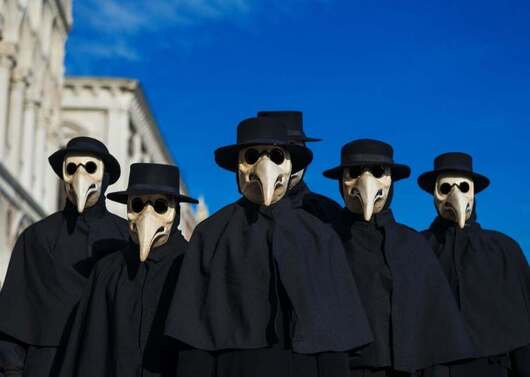|
One of the more intriguing aspects of the Venice Carnevale is the beautifully fantastic cartapesta masks attendants wear. Many are colorful, feathery, glittered and elegant. But there is one long, bird-beaked mask that can creep out most who come across it... the Medico della Peste or Dottore Peste (plague doctor). This birdlike mask wasn't originally designed for the pleasures of Carnevale, but in fact was was invented in the 17th century by French physician Charles de Lorme to protect doctors airborne bacteria and viruses while treating victims of the plague. Carnival goers eventually started wearing a decorated version called Memento Mori, to remind them of their own mortality. In the 1600s, the beak was to be filled with aromatic and medicinal herbs to protect them from putrid air, which at that time was seen as the cause of infection. Often the city or town paid their fees, and some plague doctors were known to charge patients and their families (especially the wealthy) additional fees for special treatments for false cures. These so called "doctors" were often lay people without medical training, their only apparent useful purpose was in detailing and recording how many of the population were actually affected by plague. Even though these plague doctors offered little real healing, their value to the ruling class and local governments were overly inflated. In Florence and Perugia, doctors were often asked by officials to perform autopsies to help determine how the plague played a role. The city of Orvieto hired plague doctor Matteo fu Angelo in 1348 for four times the normal annual rate of a traditional doctor. Pope Clement VI hired several extra plague doctors during the Black Death to attend to stricken in Avignon. Of 18 doctors in Venice, only one was left by 1348: five had died of the plague, and 12 were missing and may have fled. Their special costume were first used in 1630 in Naples, and spread to be used throughout Europe. The spooky attire consisted of a light, waxed fabric overcoat, a mask with glass goggles and that frightening beak. They carried a scalpel for cutting open blisters (the goggles protected their eyes from the spatter) The wide brimmed hat identified most doctors during this time. Around their neck they wore a pomander which contained more herbs and aromatics--again, to protect themselves. They also kept and chewed raw garlic whenever near the inflicted. Their long cloak went nearly to the ground and was waxed heavily to ward off damp and fleas--possible carriers of the disease. They also carried a long cane to poke and probe patients during examinations and treatments, to avoid actually touching them. As mentioned earlier, that beak was stuffed with herbs, straw, and spices. The scented materials included juniper berry, ambergris, rose hips, mint, camphor, cloves, laudanum and myrrh.
Historic facts prove that these charlatans in their scary costumes did little to heal or prevent the plague in Italy. The Italian Plague of 1629–1631 was a series of outbreaks of bubonic plague which ravaged northern and central Italy. This epidemic claimed possibly one million lives, or about 25% of the population in these regions. Verona lost over 60% of its citizens. Milan lost 46%. In Venice, one third died. Stay healthy, amici. --Jerry Finzi |
On AMAZON:
|








 RSS Feed
RSS Feed

